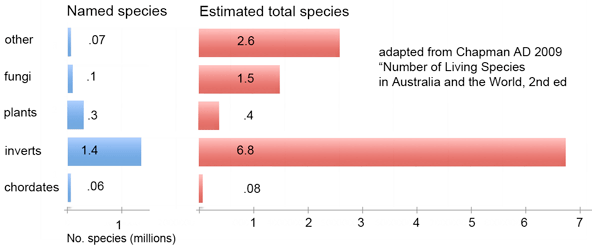World species census updated
How many species are there? One widely cited estimate, now 24 years old, is 1.7 million named species (EO Wilson 1985 Science 230:1227). This estimate is updated in detailed form in September 2009 publication from Australian Government “Numbers of Living Species in Australia and the World, 2nd edition” by Arthur Chapman (illustrated report open access for perusing online or as pdf for download). According to Chapman’s analysis, there are 1.9 million published species in the world. Approximately 18,000 new species are described each year, 75% of which are invertebrates, 11% vascular plants, and 7% vertebrates. Chapman estimates the true number of world species is about 11 million. The largest uncertainties, for which it is estimated fewer than 10% of species have been named, are for fungi, single-celled eukaryotes (protocista, cyanophyta, chromista), and “prokaryotes”, i.e. eubacteria and archaea.

This overview brings to mind pictures of the distribution of matter and dark matter in the universe. On a large scale, is the “density” of species uniform? For example, given there about about 10,000 bird and about 40,000 fish species, do fish take up 4x as much diversity space? We know on a small scale there are some “high-density” closely-related groups of species, like cichlid fishes in Africa, but can we map the distribution of diversity on a larger scale? Large databases of homologous sequences representing diverse species (aka DNA barcodes; as of today, BOLD has over 700,000 records representing over 64,000 species) and new mathematical approaches to calculating diversity from nucleotide sequences (eg Sirovich 2009 PLoS ONE; I am co-author) may help provide a biological macroscope (Ausubel PNAS 2009) for understanding the genetic structure of biodiversity, complementary to the historical view expressed in the Tree of Life.
This entry was posted on Tuesday, October 6th, 2009 at 9:52 pm and is filed under General. You can follow any responses to this entry through the RSS 2.0 feed. Both comments and pings are currently closed.
January 26th, 2010 at 3:01 pm
I currently study in Queensland Australia and in one of my classes our teacher had us read the “Numbers of Living Species in Australia and the World, 2nd edition” report. I found this to be very interesting and was shocked to read that 18,000 new species are being described each year and in 2007 75% of those were invertebrates. Our teacher took the class on a field trip and we got the chance to see some of these amazing species. The hole class was in shock that their were so many species that have not been identified or named yet.